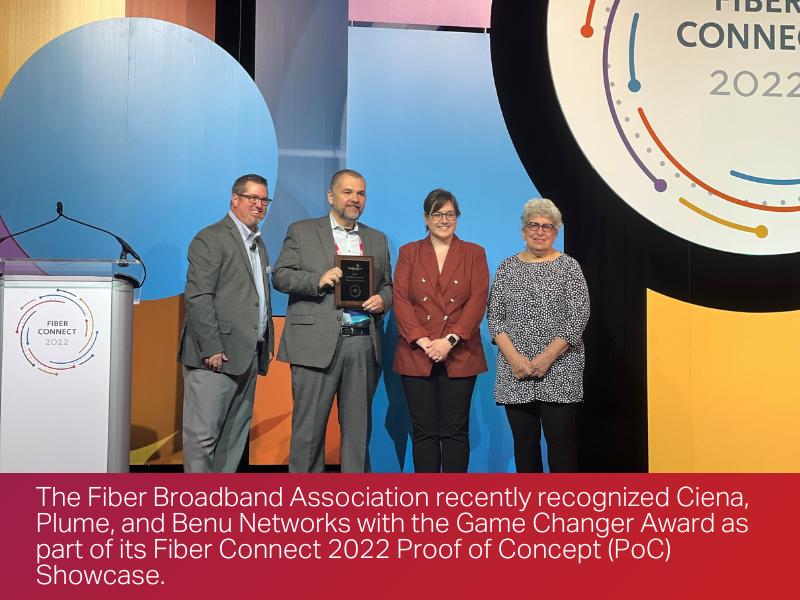Futureproof your residential broadband network, without a crystal ball
For most, buying a new tech like the latest smartphone or a computer is a significant personal expense. We want it to last as long as possible before becoming obsolete. We want to protect our investment and ensure we’ll be able to use our preferred applications with a great quality of experience (QoE) for as long as possible. On the other hand, we don't want to overspend on features and functionalities that won’t be relevant in the future.
We can quickly draw a parallel with service providers' challenges in deciding which technologies to use when deploying broadband network infrastructure. They want to invest in a solution that supports existing customers and applications requirements, while providing a viable evolution path, without needing a massive rebuild that strand initial investments.
At first glance, it seems simple, as most existing solutions claim to be future-proof, future-ready, or variations of the same concept. The main challenge is predicting future broadband network requirements when you don't have a crystal ball.
Prediction is very difficult, especially if it's about the future. - Niels Bohr
In his WWDC conference keynote in June of this year, Apple CEO Tim Cook stated that Apple has over 34 million registered developers working to create the most innovative and exciting applications that will push the boundaries of existing network capabilities to an unpredictable limit.
Another good example of how hard it is to predict the network's future requirements is the metaverse. We’re hearing a lot about how it will revolutionize the way we work, play, learn, and socialize with each other. The truth is we barely scratched the virtual surface of the metaverse. The devices, platforms, and industry ecosystem are in embryonic stages.
As a fundamental component of the metaverse, the network connectivity must evolve to support the new requirements, but we have many more questions than answers now. What are these requirements? Will 1Gb/s connectivity per user be enough? Will they need half of that? Will WiFi 6E be the right technology, maybe WiFi 7, or will we need an entirely different set of protocols and capabilities? What about latency limits? Security? Sustainability?
These are questions studies are attempting to answer. However, although we have some visibility for initial metaverse applications, it’s tough to foresee two or three years into the future.
A "future-ready broadband network solution” must be more than a buzzword
The broadband network connectivity market requires a lot of investment, in a moment where service providers are adopting fiber-based access technologies, like XGS-PON, to address the expected QoE to their customers. In this scenario, protecting their investment and competitive edge is paramount.
A complete end-to-end broadband network involves multiple components. For example, a fiber-to-the-home (FTTH) network providing residential broadband network connectivity has several components such as the optical network unit (ONU), WiFi gateway, optical line terminal (OLT), aggregation or middle-mile device, IP edge, IP core, and the subscriber manager performed by the broadband network gateway (BNG).

These components have different functions, requirements, and innovation cycles yet they must all work seamlessly together.
When we add the unpredictability of requirements of new applications with the diversity of broadband network components, it’s clear no single technology vendor can deliver best-in-breed innovation for all parts of a network and maintain pace with continually evolving use cases and applications.
Futureproofing your broadband network doesn’t make sense without openness
At first glance, investing in closed and proprietary solutions from a single vendor may look like a good way to simplify the procurement process, network implementation, and operations. The real challenge starts when application requirements evolve, or competitors develop an innovative solution that impacts your ability to grow your business. At this moment, you’ll realize that tying your ability to innovate to a single vendor's R&D capacity and associated technology roadmap is risky, as it may not align with your future business needs.
In many adjacent areas, where innovation is an essential competing factor, openness is the single most important characteristic to futureproof your network. An excellent example is 5G with the O-RAN Alliance, and residential broadband networks are no different.
A typical FTTH network, implements an access solution based on XGS-PON, with a clear path to 25GS-PON, and an aggregation infrastructure supporting multiple 100GbE, 200GbE, or 400GbE ports will provide sufficient scalability to sustain new application requirements for years to come. However, when you get to the customer premises, innovation cycles accelerate with new protocols and technologies appearing almost annually that can impact your ability to remain competitive. The same happens in subscriber management, automation, or OSS/BSS.
Openness is part of Ciena’s DNA
At Ciena, we believe in embracing openness through adopting open protocols and interfaces, supporting open APIs, and collaborating with a broader vendor ecosystem is the best way to help our customers implement future-proof and sustainable networks.
Unlike closed and legacy approaches, Ciena helps you build an open network that easily integrates with your existing infrastructure to enhance your service offerings by building infrastructure with multiple vendors. This creates a best-in-breed solution enhancing your competitive edge without limiting your future.
Another vital topic of evolving from a closed to an open approach is the inherent complexity of integrating multiple vendor solutions. By understanding that this mission may surpass your existing capabilities, Ciena’s System Integration services can support you during this process by pre-validating and pre-integrating different vendors to guarantee a streamlined end-to-end network. This way, you don't have to compromise between deploying a simple and best-in-breed residential broadband network. You can have both.
Ciena residential broadband solution is a recognized game changer
Openness, multi-vendor, and best-in-breed were central concepts of the proof of concept (POC) Ciena presented this year at the FiberConnect event. By working with other industry leaders, an end-to-end residential broadband solution was implemented and demonstrated including our highly modular and scalable FTTH portfolio based on XGS-PON and routing technology, as well as Benu Networks’ disaggregated and virtualized subscriber management (BNG) and Plume’s WiFi gateway and WiFi and customer QoE management platforms.

In addition to the unanimous validation we received from customers during the multiple discussions at the event, our POC was evaluated by influential industry analysts and received the Game Changer Award, reinforcing how vital openness and cross-vendor collaboration are to the future of the residential broadband network's implementations.
Having the freedom to choose which vendor provides the best offering for every component of your residential broadband network yields a best-in-breed, future-ready solution. Any other option will require a crystal ball to ensure that your business future aligns with a single vendor’s future investment focus and product roadmap.








